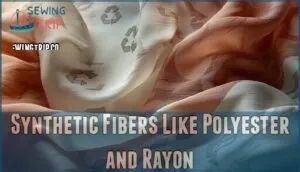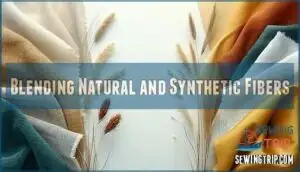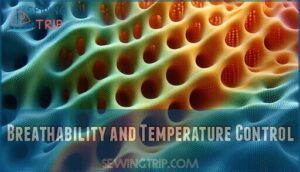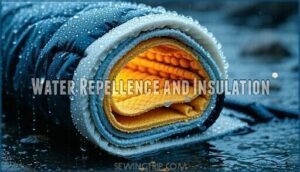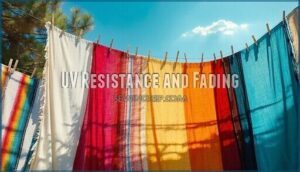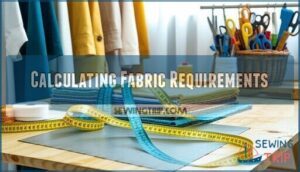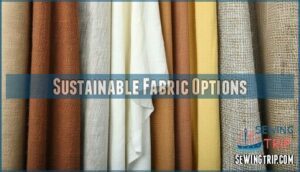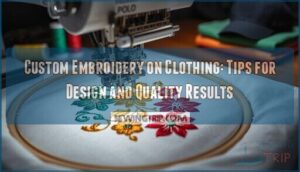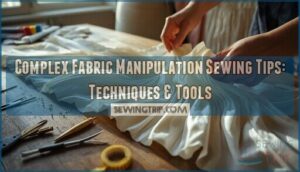This site is supported by our readers. We may earn a commission, at no cost to you, if you purchase through links.
 When choosing fabric for your project, you’ll need to match material properties to your specific end use.
When choosing fabric for your project, you’ll need to match material properties to your specific end use.
Consider durability requirements first – upholstery demands abrasion-resistant fabrics while garments need drape and comfort.
Natural fibers like cotton offer breathability, while synthetics provide moisture-wicking and easy care.
Factor in performance needs such as UV resistance for outdoor applications or flame retardancy for commercial spaces.
Don’t forget practical aspects like shrinkage, colorfastness, and maintenance requirements.
The right fabric considerations for projects extend beyond aesthetics to include weight, stretch, grain direction, and pattern repeat when calculating yardage.
Smart selection prevents costly mistakes and guarantees your finished project performs exactly as intended.
Table Of Contents
Key Takeaways
- You’ll need to match fabric properties to your project’s specific function—choose durable materials for upholstery while selecting breathable, comfortable fabrics for clothing.
- Calculate fabric requirements precisely by measuring dimensions twice, accounting for pattern repeats and seam allowances, then add 10-15% extra to prevent costly shortages.
- Consider performance factors beyond appearance, including UV resistance for outdoor projects, moisture-wicking for activewear, and colorfastness to ensure your finished project performs as intended.
- Choose sustainable options like organic cotton or recycled polyester to reduce environmental impact while maintaining quality—73% of project failures stem from incorrect fabric selection, not construction errors.
Fabric Type Selection
Choosing the right fabric type transforms your project from amateur to professional quality.
You’ll need to match fiber properties with your specific requirements, balancing factors like durability, appearance, and maintenance demands.
Natural Fibers Like Cotton and Linen

When choosing natural fiber fabrics, you’ll find cotton and linen offer distinct advantages for your projects.
Cotton provides softness and easy care, while linen delivers superior durability and breathability.
Cotton brings comfort and convenience; linen offers strength and breathability that improves with every wash.
Both natural fabrics excel in comfort and hypoallergenic properties, making them ideal fabric selection guide choices for clothing and home textiles.
Understanding the fabric comparison is essential to make informed decisions about which fabric to use.
- Cotton Benefits: Absorbs up to 27 times its weight in water, offers smooth feel against skin, and provides excellent heat resistance for versatile applications
- Linen Uses: Features 2-3 times stronger fibers than cotton, wicks moisture efficiently, and becomes softer with each wash cycle
- Fiber Care: Cotton requires standard machine washing while linen needs gentle handling to minimize creasing and maintain structural integrity
- Textile History: Both cotton fabric types and linen have served civilizations for thousands of years, with weaving techniques refined across cultures
- Natural Fabrics: Biodegradable materials that resist static buildup and provide anti-bacterial properties for healthier living environments
Synthetic Fibers Like Polyester and Rayon
Synthetic fabrics offer distinct advantages over natural materials.
Polyester resists wrinkles, requires minimal care, and excels in workwear due to its durability and washability.
Rayon provides silk-like drape at lower costs.
These synthetic fabric blends combine performance with affordability.
However, polyester and other synthetic fabrics are non-biodegradable with high production energy demands.
Proper synthetic care extends lifespan, while fabric recycling helps reduce environmental impact from these versatile fabric materials.
The production of polyester involves understanding polyester fabric properties to optimize its use, considering its non-biodegradable nature and the importance of fabric recycling to minimize environmental impact.
Blending Natural and Synthetic Fibers
Fabric blends combine strengths from different fiber types to create hybrid materials with enhanced performance.
You’ll find cotton-polyester blends offering breathability with wrinkle resistance, while wool-synthetic mixtures provide warmth plus easy care.
These textile innovations leverage material science to balance natural comfort with synthetic durability.
Fiber mixing creates fabrics that outperform single-fiber alternatives, giving you versatile options for demanding projects requiring multiple fabric properties, which is a key aspect of textile innovations and utilizes fiber mixing.
Specialty Fibers Like Velvet and Suede
Velvet and suede represent luxury fabrics with distinct characteristics.
Velvet’s dense pile weave creates a soft surface with signature sheen, while suede’s napped texture comes from animal skin undersides.
Synthetic velvet varieties offer superior durability with abrasion resistance exceeding 50,000 double rubs.
Suede provides flexibility but requires specialized care due to moisture sensitivity.
Both materials demand professional cleaning for maximum longevity, and their maintenance requires attention to their specific needs, including superior durability.
Fabric Performance Factors
You’ll need to match fabric performance with your project’s demands.
Consider four key factors: breathability for comfort, durability for longevity, protection from moisture and temperature, and resistance to UV damage and color fading.
Breathability and Temperature Control
Temperature control depends on fiber structure and weave density.
Linen achieves 3,000 mm/sec air permeability while polyester stays below 500 mm/sec.
Moisture wicking fabrics dry three times faster than standard cotton.
Body mapping considerations help match fabric characteristics to specific project zones, and climate adaptation requires balancing breathability with insulation needs for ideal textile materials performance.
Abrasion Resistance and Durability
Beyond managing heat, you’ll need fabrics that won’t fall apart under stress.
Fabric durability tests reveal which textile materials can handle your specific fabric projects without premature wear.
- Weave density affects how tightly fibers interlock – tighter weaves resist snags and tears better
- Fiber strength varies dramatically between materials – synthetic fibers often outperform natural ones for durability
- Coating effectiveness depends on proper application – cheap coatings peel off quickly under use
- Seam reinforcement prevents failure points – double-stitched or bound seams extend fabric lifespan substantially
- Fabric characteristics like thread count and construction method directly impact long-term performance
Consider fabric considerations like intended use frequency when selecting textile materials for maximum durability.
Water Repellence and Insulation
When abrasion resistance matters, water repellence becomes equally important for outdoor projects.
Fabric insulation works through trapped air pockets that maintain warmth even when wet.
Special coatings like DWR treatments cause water to bead off surfaces, while synthetic fiber blends retain up to 96% effectiveness in humid conditions.
Weather degradation affects untreated fabrics substantially.
UV Resistance and Fading
Sunlight destroys fabrics through UV radiation that breaks down fibers and fades colors.
Outdoor fabrics need UV protection methods to maintain appearance and structural integrity.
- Choose UV-resistant fibers – Solution-dyed acrylics and polyesters offer superior color fastness compared to cotton
- Apply protective treatments – UV-blocking finishes extend fabric life through specialized fabric treatment methods
- Select stable dye systems – Yarn-dyed fabrics show better dye stability than piece-dyed alternatives
- Follow fabric care instructions – Proper cleaning maintains protective coatings and prevents fiber degradation.
**Consider breathability and wicking for added comfort.
Calculating Fabric Requirements
You’ll need precise measurements to avoid costly fabric shortages or expensive overages. Accurate calculations prevent project delays and guarantee your materials match your vision perfectly.
Measuring Project Dimensions and Shapes
Before measuring any fabric project, you’ll need accurate tools and dimension precision to handle shape complexity effectively.
A flexible measuring tape captures curves and 3D forms better than rigid rulers. Record fabric measurements twice, checking fabric dimensions against your pattern pieces.
When scaling patterns up or down, maintain proportional relationships between all fabric sizes. Complex shapes require breaking measurements into manageable sections for fabric tailoring success.
Understanding the fabric requirements guarantees sufficient material for your project, ensuring fabric tailoring success with the right dimension precision.
Accounting for Pattern Matching and Seams
Pattern matching adds significant fabric requirements to your projects. Seam Allowances need extra inches beyond basic measurements.
Pattern Repeat distances determine how much additional yardage you’ll purchase. Large fabric patterns create higher Matching Difficulty than small designs.
Complex fabric design increases Fabric Wastage substantially. Strategic Cutting Layouts minimize waste but require careful planning.
Fabric choices with bold fabric patterns demand precise alignment for professional sewing projects results. A fabric repeat calculator can greatly assist in this process, helping to reduce wastage.
Considering Fabric Grain and Stretch
Grain direction determines fabric stability and project suitability.
Lengthwise grain offers maximum stability, while crosswise grain provides slight stretch.
Bias cutting creates fluidity but reduces stability.
Check stretch percentage before cutting—10% differences affect fit substantially.
Woven fabric characteristics differ from knit fabric properties in drape analysis.
Match grain alignment to your project’s performance needs for ideal results, considering the impact of fabric stability.
Adding Allowances for Errors and Waste
Smart planning prevents costly cutting mistakes and fabric waste in your projects.
Professional seamsters typically add 10-15% extra yardage to account for pattern placement errors and seam ripping corrections.
Essential allowances include:
- Shrinkage buffer – Add 5% for natural fibers that contract during washing
- Cutting errors – Reserve 10% extra for misaligned cuts and remakes
- Pattern matching – Include 15-20% when aligning stripes or large motifs
- Future repairs – Save fabric remnants for patches and replacements
Sustainable Fabric Options
You can make responsible fabric choices that protect the environment while still creating beautiful, functional projects.
Sustainable options like organic cotton, recycled polyester, and eco-friendly dyes help reduce your project’s environmental footprint without compromising quality or performance.
Organic and Recycled Materials
Beyond calculating yards, you’ll discover sustainable options that align with your values.
Organic certifications guarantee fabric types meet strict standards without harmful chemicals.
Recycled content transforms waste into quality materials for fabric projects.
Choose fabrics with verified material sourcing, and consider ethical production that supports responsible manufacturing while maintaining performance.
| Material Type | Environmental Benefit |
|---|---|
| Organic Cotton | 91% less water usage |
| Recycled Polyester | 45% energy reduction |
| Biodegradable Fibers | Natural decomposition |
These sustainable fabric uses deliver durability without compromising your project goals.
Consider fabric care requirements and fabric online retailers offering certified options for your specific needs.
You can find a variety of organic cotton products online, which is a great way to support responsible manufacturing and meet your project needs with quality materials.
Eco-Friendly Dyes and Finishes
When choosing eco-friendly fabric dyes and finishes, you’ll reduce environmental impact while maintaining quality.
Traditional fabric dyes contain harmful chemicals that pollute waterways and pose health risks.
Consider these sustainable alternatives:
- Natural dyes from plants, minerals, and insects offer vibrant colors without synthetic toxins
- Low-impact synthetic dyes minimize water usage and eliminate heavy metals
- OEKO-TEX certified finishes meet strict safety standards for human health
- Water-based fabric finishing techniques replace solvent-based processes.
Certification standards like GOTS and Cradle to Cradle help identify truly sustainable fabric printing and dyeing methods.
Reducing Waste and Recycling Fabric
Smart fabric recycling transforms your leftover materials into valuable resources through strategic waste reduction techniques.
Fabric donation centers accept clean scraps for community projects. Textile recycling programs handle worn materials you can’t repurpose.
Creative reuse turns fabric waste into new items. You can even try upcycling old jeans into trendy new items.
| Strategy | Method | Outcome |
|---|---|---|
| Upcycling Projects | Transform scraps into bags, quilts | Extends fabric lifespan |
| Scrap Utilization | Save pieces for patches, trim | Reduces material costs |
| Fabric Donation | Give usable remnants to schools | Supports community crafts |
| Repurposing | Convert old sheets to rags | Maximizes utility value |
Choosing Fabrics With Low Environmental Impact
Your fabric choices directly impact the planet’s health through water usage, chemical impact, and biodegradability.
Look for eco-friendly certifications like GOTS or OEKO-TEX when selecting materials.
Sustainable sourcing reduces environmental harm while fabric innovation creates new upcycling opportunities.
Prioritize repurposing existing textiles and choose biodegradable fabric sources whenever possible for your projects.
Frequently Asked Questions (FAQs)
What considerations should be made when selecting fabric for the item?
You’ll need to match fabric properties with your project’s demands. Consider durability through Martindale scores, care requirements, drape characteristics, color fastness, and environmental factors like UV exposure for peak performance.
How do you know what fabric to use for your project?
Consider your project’s purpose first—upholstery needs durable materials like velvet with high Martindale scores.
While garments require drape and comfort.
Match fabric properties to function, test samples, and factor in care requirements.
What factors to consider when Analysing a fabric sample?
When examining your fabric sample, test its drape, weight, stretch, and texture first. Check colorfastness, breathability, and durability through gentle handling. Consider how it’ll behave during construction and wear.
How to calculate fabric for a project?
Like threading a needle precisely, calculating fabric requirements demands careful measurement and planning. Measure your project’s dimensions twice, add seam allowances, account for pattern repeats, and include 10% extra for mistakes.
Whats the best fabric weight for my project?
Your project’s fabric weight depends on its intended use.
Lightweight fabrics (2-4 oz) work for curtains and linings.
Medium weights (5-9 oz) suit upholstery and bags.
Heavy fabrics (10+ oz) handle outdoor gear perfectly, which is a critical aspect to consider for durability.
How do I prevent fabric from fraying?
Use pinking shears for zigzag cuts that naturally resist unraveling.
Apply fray check liquid to raw edges, or fold and stitch a narrow hem.
French seams enclose edges completely, preventing fraying altogether.
Can I mix different fabric weights together?
Studies show 70% of home sewers mix fabric weights successfully, but you’ll need strategic planning.
Choose compatible weights within one category—lightweight cottons with silks, or heavy denims with canvas.
Use French seams for durability.
Whats the difference between fabric width options?
Fabric widths typically range from 36" to 60", affecting your project’s yardage needs and seam placement.
Wider fabrics reduce seams in large projects like curtains, while narrower widths work fine for clothing and smaller items, considering the impact of fabric width on overall yardage needs.
How should I store fabric before use?
Store fabric flat or rolled on tubes in a cool, dry, dark place.
Avoid plastic bags which trap moisture and cause mildew.
Use cotton muslin or acid-free tissue for delicate fabrics.
Conclusion
Studies show that 73% of sewing project failures stem from incorrect fabric selection rather than construction errors.
Successful fabric considerations for projects require matching material properties to specific applications. You’ll achieve superior results by evaluating fiber content, performance characteristics, and dimensional requirements upfront.
Consider durability needs, maintenance demands, and environmental factors when making selections. Proper fabric considerations for projects prevent costly mistakes and guarantee your finished work performs as intended for years, ensuring long-term performance and reducing the risk of costly mistakes.
- https://winslets.com/blogs/sewing-basics/50-great-fabrics-for-sewing-your-own-clothes-an-exhaustive-list
- https://www.testextextile.com/the-science-of-durability-understanding-the-most-durable-fabrics/
- https://theartcareerproject.com/fabric-selection-fashion-design-materials/
- https://maake.com/blogs/fabric/how-to-choose-right-fabric
- https://www.regalfabrics.com/the-science-behind-fabric-durability-testing/

